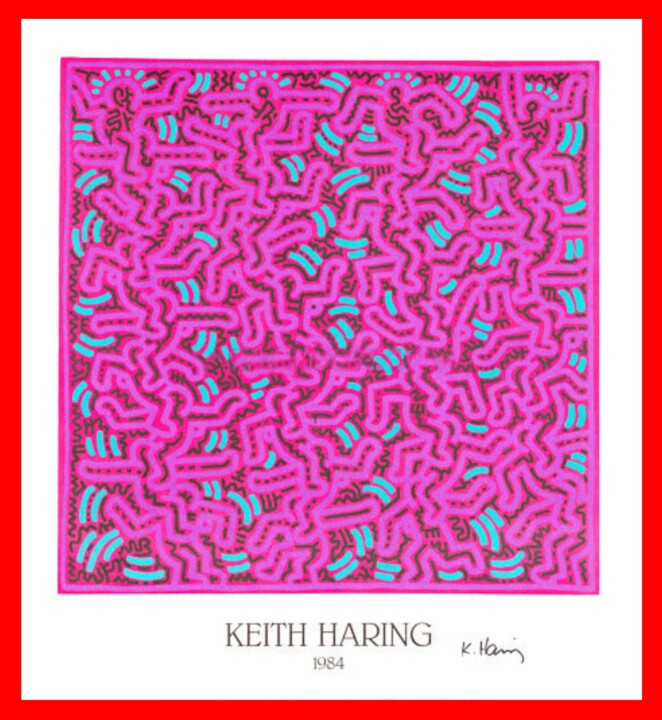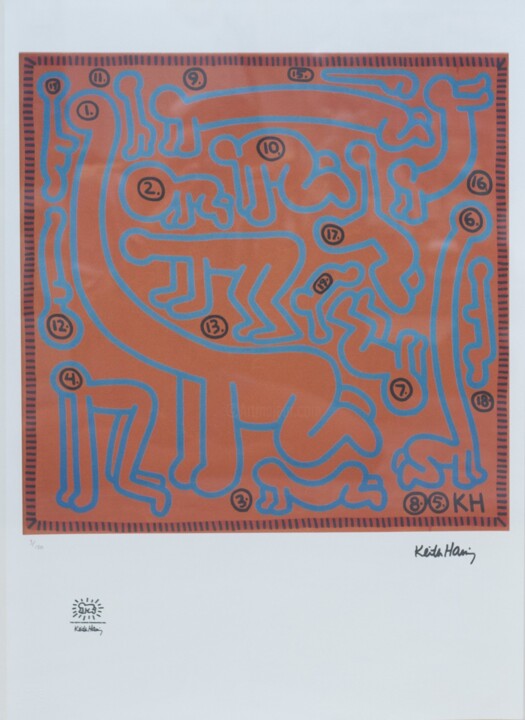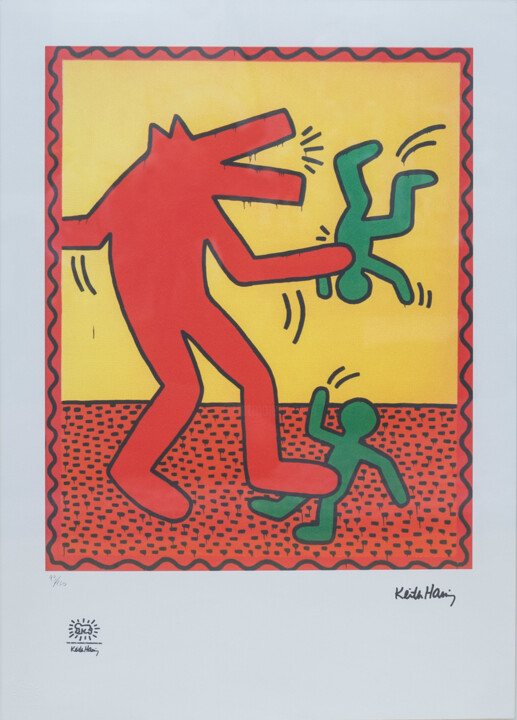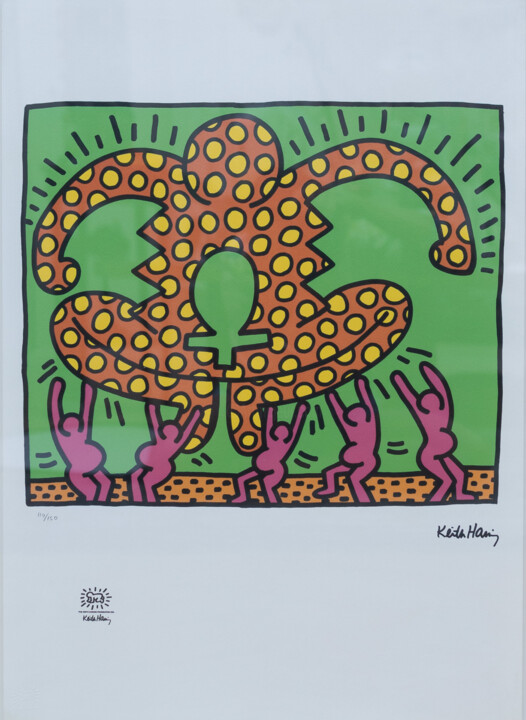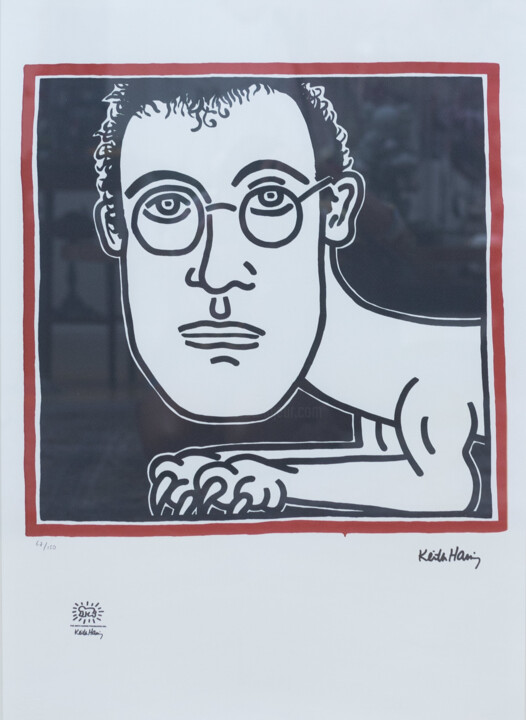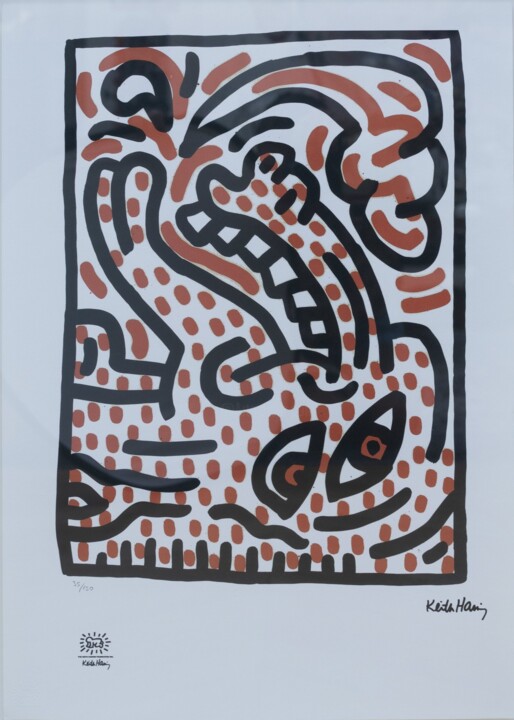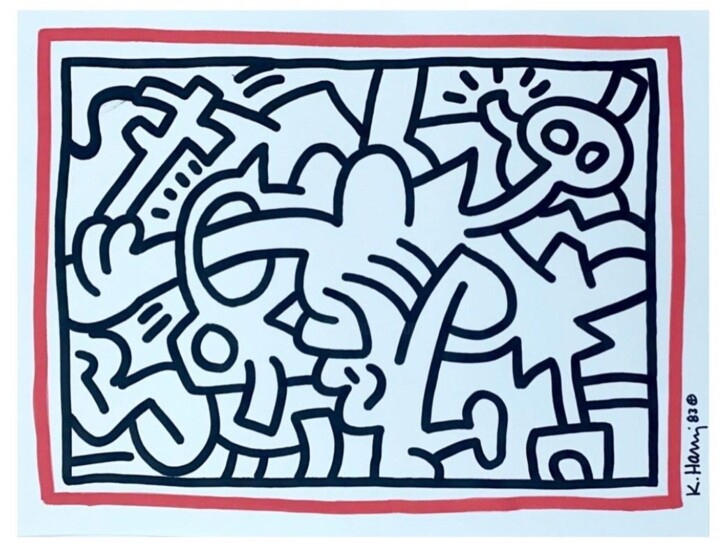Keith Haring was an iconic American artist known for his vibrant, bold, and energetic artwork that often featured a mix of symbols, figures, and patterns. His unique style transcended traditional art boundaries, transforming everyday urban spaces into dynamic canvases. Haring’s art was a powerful form of social commentary, reflecting themes of love, birth, death, and war, resonating with a broad audience and making art accessible to everyone.
A Life in Lines and Colors
Keith Haring was born on May 4, 1958, in Reading, Pennsylvania, and grew up in Kutztown. From a young age, he displayed a natural talent for drawing, inspired by Disney cartoons, Dr. Seuss, and Looney Tunes. His supportive family, particularly his amateur cartoonist father, Allen Haring, nurtured his artistic inclinations.
After briefly attending the Ivy School of Professional Art in Pittsburgh in 1976, Haring moved to New York City in 1978 to enroll at the School of Visual Arts (SVA). There, he immersed himself in the vibrant street art culture, drawing inspiration from graffiti and contemporary artists like Jean Dubuffet and Pierre Alechinsky.
Haring began creating chalk drawings on subway advertising panels, featuring bold lines and motifs such as radiant babies and barking dogs. These spontaneous works captured public attention and became iconic symbols of his style. By the early 1980s, Haring was a prominent figure in the East Village art scene, collaborating with artists like Jean-Michel Basquiat and Andy Warhol.
Haring's art was deeply intertwined with social activism. He addressed issues such as apartheid, the crack cocaine epidemic, and AIDS awareness. Diagnosed with AIDS in 1988, he continued to create impactful art, raising awareness and funds for AIDS research. In 1989, he founded the Keith Haring Foundation to support AIDS research, children's programs, and arts education.
Haring's life was tragically cut short when he died of AIDS-related complications on February 16, 1990, at age 31. Despite his brief career, his vibrant art and commitment to social causes have left a lasting legacy, inspiring and influencing new generations of artists and activists.
The Artistic Language of Keith Haring: Style, Movement, and Meaning
Keith Haring's artistic style is instantly recognizable, defined by its use of bold lines, bright colors, and a set of recurring motifs that convey a sense of movement and energy. His visual language, developed in the vibrant cultural landscape of 1980s New York City, is a unique blend of graffiti art and pop art, characterized by its accessibility, immediacy, and profound social commentary.
Haring's work features a distinct palette of radiant colors—reds, yellows, blues, and greens—that he used to create a sense of vibrancy and dynamism. The boldness of his lines and the simplicity of his forms belie the complexity of the messages they convey. His figures are often outlined in thick black, a technique that not only emphasizes their shapes but also gives them a sense of immediacy and presence, as if they are jumping off the surface.
Among the most iconic elements of Haring's style are his recurring motifs. Dancing figures, with their dynamic postures and rhythmic repetition, convey a sense of joy, unity, and movement. The radiant baby, often depicted with lines emanating from it, symbolizes purity, potential, and the future. Barking dogs, which appear frequently in his work, serve as symbols of loyalty, protection, and alertness, but also of social critique and resistance. Flying saucers, another recurring image, add a whimsical, otherworldly dimension to his work, suggesting a sense of exploration and the unknown.
Haring's style was heavily influenced by the graffiti and street art that flourished in New York City during the late 1970s and 1980s. This movement, characterized by its rebellious spirit and public accessibility, resonated deeply with Haring. He was drawn to the idea of art as a democratic form of expression, one that could reach people in their everyday environments. This ethos led him to create art in public spaces, such as subway stations, walls, and billboards, making his work accessible to a wide audience outside the confines of galleries and museums.
The pop art movement, particularly the works of Andy Warhol and Roy Lichtenstein, also influenced Haring's approach. From Warhol, he adopted the use of repetitive imagery and the merging of high and low art forms. From Lichtenstein, he drew inspiration in using bold, graphic lines and vibrant colors. These influences helped Haring develop a style that was both visually engaging and rich in social commentary.
Haring's friendship and collaboration with Jean-Michel Basquiat further enriched his artistic development. Basquiat's raw, expressive style and his ability to infuse his work with powerful social and political messages inspired Haring to explore similar themes in his own art. Together, they pushed the boundaries of what art could be, both in terms of form and content.
Central to Haring's work was his commitment to addressing social issues through his art. He used his visual language to comment on and critique the world around him. The AIDS crisis, which profoundly affected him personally and claimed the lives of many of his friends, was a recurrent theme in his work. Pieces like "Ignorance = Fear / Silence = Death" served as stark reminders of the epidemic's human toll and the importance of awareness and activism.
Haring also tackled issues such as apartheid and the crack cocaine epidemic. His mural "Crack is Wack," created on a handball court in Harlem, was a powerful public service announcement highlighting the devastating effects of drug addiction. Through his art, Haring sought to raise awareness, provoke thought, and inspire action on these critical issues.
Haring's commitment to public art and social commentary made him a key figure in the 1980s New York City graffiti art movement. He saw art as a tool for communication, a way to reach people directly and engage with them on important social issues. His work broke down barriers between high art and popular culture, making profound statements in a visually accessible and engaging manner.
Iconic Creations: Symbols of Social Commentary and Public Engagement
Keith Haring's art is renowned for its vibrant visual style and poignant social messages. His work features several iconic pieces that have left a lasting impact.
The "Radiant Baby" is one of Haring's most recognizable symbols, representing purity, innocence, and potential. This image, with lines radiating from a crawling baby, appears in various forms across Haring's works, symbolizing hope and the future.
Created in 1986, the "Crack is Wack" mural on a Harlem handball court addresses the crack cocaine epidemic with bold lines and vivid colors. It serves as a stark warning about the dangers of drug addiction and highlights Haring's commitment to social awareness.
This 1989 artwork responds to the AIDS crisis, featuring three yellow figures covering their eyes, ears, and mouths. The bold red and yellow colors and urgent phrases "Ignorance = Fear" and "Silence = Death" call for open confrontation of the epidemic and fight against stigma.
In the early 1980s, Haring's "Subway Drawings" utilized empty advertising panels in NYC subway stations. These chalk drawings engaged the public directly, democratizing art and establishing Haring as a key figure in the street art movement.
Haring's extensive oeuvre includes collaborations with artists like Jean-Michel Basquiat and Andy Warhol, public murals like the one on the Berlin Wall, and a series of paintings and sculptures. His "Pop Shop" in NYC, opened in 1986, offered affordable art and merchandise, furthering his mission to make art accessible to everyone.
Exploring Keith Haring 's Artwork
 Printmaking depicting an anthropomorphic red figure by Keith Haring
Printmaking depicting an anthropomorphic red figure by Keith Haring
Anthropomorphic Red Figure
This artwork exemplifies Keith Haring's engraving, characterized by bold lines, vibrant colors, and recurring motifs. It captures his artistic vision and his dedication to social issues.
The print features a large red anthropomorphic figure with black outlines supporting a smaller green figure, while another green figure is under its feet. The background is divided into an upper section of bright yellow and a lower section with a red pattern, framed by a zigzag border. The energetic lines and primary colors are distinctive traits of Haring's graffiti-influenced style.
Rooted in street art and pop art, Haring's work emphasizes accessibility and immediacy. His figures often appear in action, surrounded by dynamic lines, adding immediacy and urgency. In this print, the interaction between the red figure and the green ones suggests a power dynamic, reflecting themes of oppression, authority, or protection. Haring's ability to infuse social commentary into simple images is evident here, potentially addressing social issues such as inequality, abuse of power, and the marginalization of certain groups.
 Printmaking depicting a Self-Portrait of the Artist by Keith Haring
Printmaking depicting a Self-Portrait of the Artist by Keith Haring
Self-Portrait of the Artist
This print presents a compelling self-portrait of Keith Haring, characterized by a large head with curly hair, round glasses, and a solemn expression atop an anthropomorphic body. The figure, outlined in bold black lines against a black background framed by a red border, combines human and animal traits, reflecting Haring's exploration of identity and societal constructs.
The simplicity and monochromatic color scheme draw attention to the figure’s expression and form, suggesting a merging of identities. This self-portrait diverges from Haring's usual motifs but maintains his signature style. It symbolizes his struggle with public and private identity, especially as a gay artist during the AIDS crisis.
Haring's art, known for its immediacy and impact, often addressed critical social issues like AIDS awareness, apartheid, and drug addiction. This piece encapsulates his unique style and ability to convey complex themes through simple yet powerful imagery, highlighting his exploration of identity and social commentary.
 Printmaking depicting Keith Haring's "Tree of Life" by Keith Haring
Printmaking depicting Keith Haring's "Tree of Life" by Keith Haring
Tree of Life: Unity and Vitality
Keith Haring, a key figure in contemporary art, is celebrated for his vibrant style blending graffiti and pop art. His works are known for bold lines, bright colors, and socially conscious messages. The print "Tree of Life," reproducing his 1985 acrylic painting, exemplifies these traits and offers rich symbolic meaning.
"Tree of Life" features a central tree-like figure made of green humanoid shapes, set against a vivid pink background with radiating lines. At the base, four orange figures with Xs for eyes stand with raised arms, adding to the sense of celebration. The thick black outlines are signature elements of Haring's style.
The dynamic green figures suggest unity and interconnectedness, emphasizing how individual lives contribute to the larger community. This aligns with Haring’s recurring themes of life, unity, and growth. The orange figures’ Xs may symbolize lost lives, reflecting on marginalized individuals.
"Tree of Life" conveys a message of unity and the vitality of life, reflecting Haring’s belief in art's power to inspire positive change. This print stands as a testament to Haring's legacy, showcasing his ability to merge striking visuals with profound social commentary.
Exhibitions and the Art Market: A Legacy of Influence
Keith Haring's influence extends beyond his vibrant murals and socially charged street art, earning acclaim in major galleries and museums worldwide and achieving high market value. His collaborations with commercial brands have further solidified his status as a cultural icon.
Haring's work has been showcased in numerous exhibitions, both during his lifetime and posthumously. A pivotal moment was his 1982 solo show at the Tony Shafrazi Gallery in New York City, which established his reputation. The Whitney Museum of American Art in New York hosted a major retrospective in 1997, highlighting his artistic journey from subway drawings to large-scale murals.
In Europe, the Centre Pompidou in Paris and the Stedelijk Museum in Amsterdam have recognized Haring's legacy. The Centre Pompidou's 2013 retrospective, "Keith Haring: The Political Line," and the Stedelijk's 2016 exhibition of the same name emphasized his activism and social relevance.
Haring's work remains highly sought after, commanding high prices at auctions. His painting "Untitled (The Marriage of Heaven and Hell)" sold for over $6.5 million at Sotheby's in 2017. Haring's prints and editions are also popular, making his art accessible to a broader audience.
Haring's public murals, such as "Crack is Wack" in New York, the Berlin Wall mural, and "Tuttomondo" in Pisa, are celebrated landmarks. His commercial collaborations, including with Swatch and Absolut Vodka, brought his distinctive designs into everyday objects, blending high art and popular culture.
These collaborations and numerous projects have expanded Haring's reach and influence, bridging the gap between art and commercial ventures. His ability to transition seamlessly between different realms highlights the enduring appeal and relevance of his work, solidifying his place as a cultural icon.
The Far-Reaching Influence of Keith Haring: Inspiring Artists Across Generations
Keith Haring’s distinctive style and profound commitment to social activism have left an indelible mark on the world of contemporary art, inspiring a diverse array of artists across various media. His ability to blend vibrant, accessible art with powerful social messages continues to resonate, influencing street artists, graphic designers, fashion icons, and musicians alike.
Two of the most prominent street artists who have drawn inspiration from Keith Haring are Banksy and Shepard Fairey. Both artists share Haring’s commitment to using public spaces to communicate powerful messages and challenge societal norms.
Banksy, the elusive British street artist known for his provocative and often politically charged works, mirrors Haring’s use of public art to provoke thought and inspire change. Banksy’s stenciled images, often laced with satirical undertones, tackle issues such as consumerism, war, and government surveillance. Like Haring, Banksy believes in the democratization of art, bringing his work directly to the streets where it can engage a broad audience.
Shepard Fairey, another influential street artist, has also been profoundly influenced by Haring’s legacy. Fairey’s work, which includes the iconic "Obey Giant" campaign and the "Hope" poster for Barack Obama’s 2008 presidential campaign, reflects Haring’s bold visual style and commitment to social justice. Fairey’s use of strong, graphic imagery and his engagement with political and social themes are direct nods to Haring’s pioneering approach to art as activism.
Haring’s impact extends beyond street art, influencing a new generation of graphic designers and visual artists who admire his ability to communicate complex ideas through simple, striking visuals. His bold use of line, color, and recurring motifs has become a touchstone for designers seeking to create work that is both visually compelling and rich in meaning.
Graphic designer and visual artist KAWS, known for his cartoon-like figures and colorful, pop-infused style, cites Haring as a significant influence. KAWS’ work, like Haring’s, blurs the lines between high art and popular culture, making use of familiar imagery to comment on contemporary society.
Illustrator and designer Jeremyville also draws inspiration from Haring’s visual language. Jeremyville’s vibrant, playful characters and community-focused projects reflect Haring’s belief in the power of art to bring people together and foster social change. His work often explores themes of mental health, community, and positivity, echoing the social messages that were central to Haring’s practice.
The fashion world has also embraced Haring’s distinctive aesthetic and his ethos of art for all. Designers and brands have incorporated his bold, graphic style into their collections, celebrating his legacy and bringing his art to a wider audience.
Fashion designer Vivienne Westwood, known for her punk-inspired creations and activism, has drawn from Haring’s vibrant visual language in her work. Westwood’s designs often incorporate bold prints and socially conscious messages, much like Haring’s art.
In 2018, the fashion house Coach released a collection featuring Haring’s iconic imagery, including the Radiant Baby and dancing figures. This collaboration introduced Haring’s work to a new generation, demonstrating the timeless appeal and versatility of his art.
Haring’s influence extends to the music industry, where his connections with musicians and his dynamic visual style have left a lasting impact. Throughout his career, Haring collaborated with numerous musicians, creating album covers, stage designs, and promotional materials that infused his bold, energetic aesthetic into the music scene.
One of his notable collaborations was with Grace Jones, for whom he painted a body suit and designed the cover for her album "Slave to the Rhythm." Haring’s work for Jones, characterized by its bold lines and vibrant energy, perfectly complemented her avant-garde style and powerful stage presence.
Haring’s friendship with Madonna also highlights the intersection of his art with the music world. He created backdrops for her concerts and participated in fundraising events to support AIDS research, reflecting their shared commitment to social causes.
Unveiling the Lesser-Known Aspects of Keith Haring's Life and Legacy
The Keith Haring Foundation
Keith Haring established the Keith Haring Foundation in 1989, a year before his death from AIDS. The foundation supports AIDS research, children's programs, and arts education, reflecting Haring’s commitment to using art to inspire change and improve lives. It continues to fund educational initiatives, provide access to the arts for underprivileged children, and support AIDS advocacy, ensuring Haring’s legacy lives on through its impactful work.
Influence of Pierre Alechinsky and the CoBrA Movement
Haring was significantly influenced by Pierre Alechinsky and the CoBrA movement, known for its raw, expressive style and spontaneity. Alechinsky's dynamic lines and fluid strokes resonated with Haring, inspiring him to blend the energy of street art with avant-garde expressiveness. This influence helped Haring develop a unique style that combined immediacy and profound social commentary.
Haring's Passion for Education
Haring was dedicated to art education, conducting workshops and visiting schools to inspire creativity, critical thinking, and social awareness in children. He believed in the transformative power of art, particularly for disadvantaged youth, emphasizing self-expression and personal development. His educational efforts underscored his belief in art’s ability to foster positive change in society.
Keith Haring's legacy as a groundbreaking artist who transformed the landscape of contemporary art remains strong. His distinctive style, vibrant expression, and commitment to social issues continue to inspire and resonate with audiences worldwide. From his humble beginnings to his rise as a global icon, Haring's work embodies the spirit of innovation and activism, ensuring that his voice remains influential in the world of art.


 Selena Mattei
Selena Mattei





